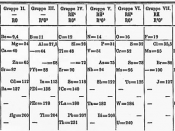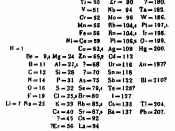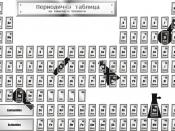The periodic table is a chart of the elements arranged according to the periodic law discovered by Dmitri I. Mendeleev and revised by Henry G. J. Moseley. In the periodic table the elements are arranged in columns and rows according to increasing atomic number. There are 18 columns, or groups, in the standard periodic table. The periodic table uses Roman numerals followed by an A or B. This method labeled columns 1 and 2 as IA and IIA, columns 3 through 7 as IIIB through VIB, column 8 through 10 as VIII, columns 11 and 12 as IB and IIB and columns 13 through 18 as IIIA through VIIIA.
There are many components that go into the creation of the periodic table, such as: families, periods, atomic radii, ionization energy, and electronegativity. A Family is a group of elements with similar chemical properties, a vertical column in the periodic table of elements.
A period is a sequence of elements arranged in order of increasing atomic number and forming one of the horizontal rows in the periodic table. An atomic radius going down a group means that the atoms get bigger as you go down, the atomic radius going across a period means that it gets smaller as you move across a period. Ionization energy decreases down a group of the Periodic Table, and increases left-to-right across a period, ionization energy is very similar to atomic radius. Electronegativity decreases down the periodic table and increases across. Additionally, atomic radius decreases across but ionization energy increases.
The horizontal rows of the table are called periods. The elements of a period are characterized by the fact that they have the same number of electron shells; the number of electrons in these shells, which equals the element's atomic number, increases from left to...


